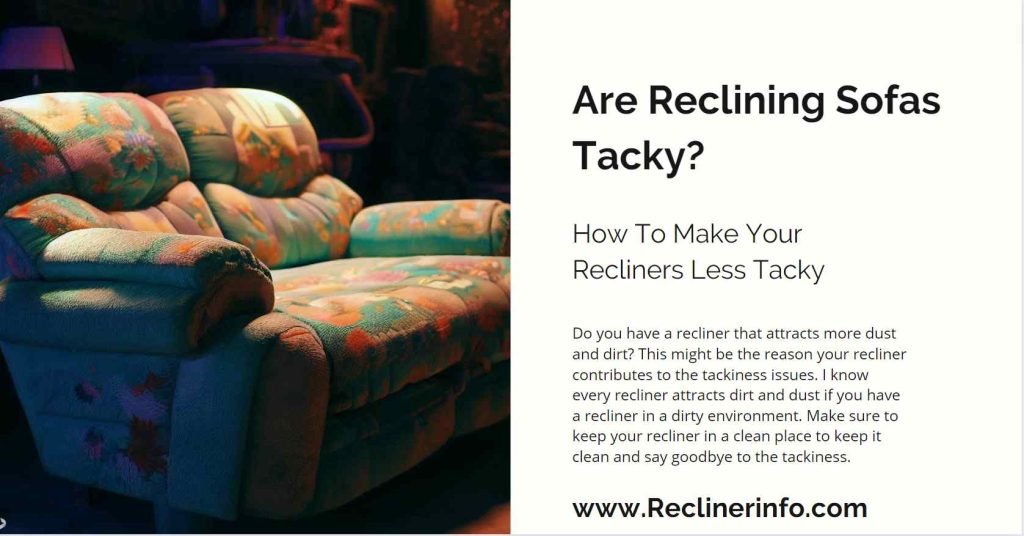After a fatigue day, you come to your favorite recliner to relax from its comfort. But it’s challenging when your recliner gets sticky. Are reclining sofas tacky? Yes, it becomes tacky if your recliner is old and dirty.
There are different reasons why your recliners are tacky such as when your recliners are too big, too mechanical, or have other technical issues.
Do you have a recliner that attracts more dust and dirt? This might be the reason your recliner contributes to the tackiness issues. I know every recliner attracts dirt and dust if you have a recliner in a dirty environment. Make sure to keep your recliner in a clean place to keep it clean and say goodbye to the tackiness.
The recliners come in different reclining positions, which optimize the comfort level allowing you to sit in your desired position.
You can avoid the recliner tackiness problem by properly caring for your recliner. You need to place the recliner in a clean room and take proper daily care to clean it from dust, dirt.
Are Reclining Sofas Tacky?
Yes, recliners get tacky for different reasons, which takes the comfort level of the recliner. Your recliners get tacky because of dirt accumulation, heat exposure, moisture, poor-quality recliner, dust, etc.
If your recliners are old, worn, and dirty, they can also be tacky. If you place the recliner in a clean room, you will not have any tackiness issues. Here are the reasons why your recliners are tacky.
Preventing Dust and Dirt Accumulation
Using your recliner in an area where the recliner attracts more dust and dirt may lead to a tacky problem. The accumulation of the particles can create a tacky problem in the recliner, which gives an unpleasant feeling while touching the recliner.
Exposure To Heat & Moisture
Exposing the recliner to heat, moisture, humidity, and high temperature may lead to a tackiness problem in the recliner. Sometimes when you expose the recliner to high heat, there are more chances of breaking down your recliner parts.
Unattractive Design of the Recliner
Most people ignore the recliner’s design but purchase it on a low budget, making your day challenging. Some recliner designs are unattractive, which sometimes leads to the tacky problem.
It may be due to the recliner’s built-in reclining mechanism, which required some additional space and strong structural components. If your recliner is bulky, it gives a less sleek and refined look.
Poor-Quality Materials
When you purchase a recliner constructed with low-quality materials, it may result in a tacky appearance. If you have a recliner with poor-quality materials such as low-grade foam or synthetic leather, which degrades quickly can create a problem for you.
Besides tackiness, there are also many other problems low-quality parts in your recliner can face. The low-quality foam recliner may lose its shape, which causes sagging issues. The low-quality synthetic leather may peel and crack and cause other issues taking the comfort of the recliner.
Spillage of Food & Other Things
If you have naughty kids or pets, there is more chance of spilling the food, and beverages, which can lead to a tacky problem. When you don’t clean those spills properly, they may leave a sticky residue that may attract dust, leading to extra issues.
Food spillage on the recliner affects your visual appearance and can lead to an unpleasant sitting experience. Sitting or sleeping on the recliner with a stickiness problem will provide an uncomfortable seating experience.
Size & Location of the Recliner
The size and location of the recliner have an overall impact on the tackiness and your room’s aesthetic experience. Suppose you have a recliner with bulky weight, so it can give an awkward feel to the overall seating experience. You may face entering or walking in the room recliner issues.
Does your recliner too small? It may not fit perfectly with other furniture in your home. Now you may be confused about what I should choose. Before purchasing the recliner, consider the size, location, weight, design, materials, and other things that suit your preference.
Additional Tips: Why Your Recliner Looks Tacky:
Here are additional tips on why your recliner is tacky.
- Poor Maintenance: You need to take care of your recliner properly so it may result in stains, wear and make a recliner less appealing.
- Tacky Upholstery Choices: If your recliner has an outdated upholstery texture, patterns can contribute to the stickiness of the recliner.
- Unbalanced Room Proportions: If you place the recliner in a smaller room or larger room so it disturbs the room’s aesthetics. Make sure to arrange all furniture in your room perfectly so it will not disturb the room’s look.
- Lack of Design Variety: Recliners have many design options, such as narrow, sleek, and large, so compare the recliner with other furniture available in your room.
How To Make Your Recliner Less Tacky
If you want to make your recliner less tacky and enhance the overall seating experience, then you need to consider the following tips and tricks.
- Choose Sleek Designs: Make sure to select a sleek, modern design with a minimalist aesthetic.
- Select Neutral Colors: Go for a neutral color recliner that matches your other room furniture.
- High-Quality Upholstery: Purchase the recliner with high-quality upholstery that gives ultimate comfort.
- Concealed Reclining Mechanism: Go for a recliner with concealed or discreet reclining mechanism, giving more comfort while reclining at different angles.
- Consider Customization: It would be better to choose a recliner with customization options, giving extra comfort.
- Regular Cleaning and Maintenance: Clean your recliner properly from stains, dust, and dirt using a vacuum cleaner or soft brush.
Final Verdict
That was all about reclining sofas, tacky or not. It’s clear that if your recliner sofas have tackiness problems, how can you reduce it to take the comfort to the next level?
There are different reasons why your reclining sofas are tacky. Some people have face recliner tackiness due to its heavy design, poor quality materials, unattractive design, heat exposure, etc.
To reduce the recliner tackiness, you need to consider the factors such as design, size, upholstery, and materials that will improve the aesthetic experience of your living room.
Which techniques are you using for your recliner to reduce tackiness? Let us know in the comments section below. It will help our readers.




